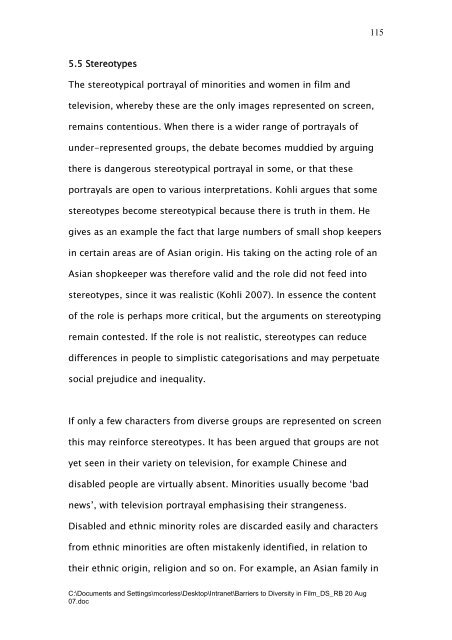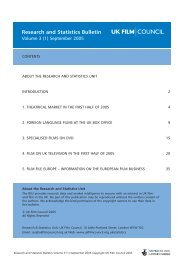Barriers to Diversity in Film – A Research Review – Aug 07
Barriers to Diversity in Film – A Research Review – Aug 07
Barriers to Diversity in Film – A Research Review – Aug 07
Create successful ePaper yourself
Turn your PDF publications into a flip-book with our unique Google optimized e-Paper software.
5.5 Stereotypes<br />
The stereotypical portrayal of m<strong>in</strong>orities and women <strong>in</strong> film and<br />
television, whereby these are the only images represented on screen,<br />
rema<strong>in</strong>s contentious. When there is a wider range of portrayals of<br />
under-represented groups, the debate becomes muddied by argu<strong>in</strong>g<br />
there is dangerous stereotypical portrayal <strong>in</strong> some, or that these<br />
portrayals are open <strong>to</strong> various <strong>in</strong>terpretations. Kohli argues that some<br />
stereotypes become stereotypical because there is truth <strong>in</strong> them. He<br />
gives as an example the fact that large numbers of small shop keepers<br />
<strong>in</strong> certa<strong>in</strong> areas are of Asian orig<strong>in</strong>. His tak<strong>in</strong>g on the act<strong>in</strong>g role of an<br />
Asian shopkeeper was therefore valid and the role did not feed <strong>in</strong><strong>to</strong><br />
stereotypes, s<strong>in</strong>ce it was realistic (Kohli 20<strong>07</strong>). In essence the content<br />
of the role is perhaps more critical, but the arguments on stereotyp<strong>in</strong>g<br />
rema<strong>in</strong> contested. If the role is not realistic, stereotypes can reduce<br />
differences <strong>in</strong> people <strong>to</strong> simplistic categorisations and may perpetuate<br />
social prejudice and <strong>in</strong>equality.<br />
If only a few characters from diverse groups are represented on screen<br />
this may re<strong>in</strong>force stereotypes. It has been argued that groups are not<br />
yet seen <strong>in</strong> their variety on television, for example Ch<strong>in</strong>ese and<br />
disabled people are virtually absent. M<strong>in</strong>orities usually become ‘bad<br />
news’, with television portrayal emphasis<strong>in</strong>g their strangeness.<br />
Disabled and ethnic m<strong>in</strong>ority roles are discarded easily and characters<br />
from ethnic m<strong>in</strong>orities are often mistakenly identified, <strong>in</strong> relation <strong>to</strong><br />
their ethnic orig<strong>in</strong>, religion and so on. For example, an Asian family <strong>in</strong><br />
C:\Documents and Sett<strong>in</strong>gs\mcorless\Desk<strong>to</strong>p\Intranet\<strong>Barriers</strong> <strong>to</strong> <strong>Diversity</strong> <strong>in</strong> <strong>Film</strong>_DS_RB 20 <strong>Aug</strong><br />
<strong>07</strong>.doc<br />
115
















